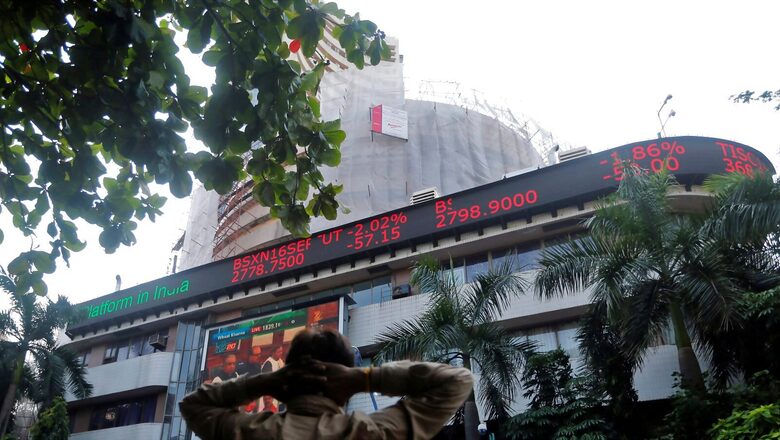
views
After back-to-back losses for four days, benchmark equity indices rose in Thursday morning after dovish commentary by the United States Fed chairman Jerome Powell boosted sentiments. However, the rally was short-lived. Around 1:50 pm on June 16, the BSE Sensex was down 800 points around 51,700-level, while the NSE Nifty skid near the 15,400-level.
The US Federal Reserve announced the most aggressive interest rate increase in nearly 30 years. It raised the benchmark borrowing rate by 0.75 percentage points to control decade-high inflation in the country. The Fed’s policy-setting Federal Open Market Committee reaffirmed that it remains “strongly committed to returning inflation to its 2 per cent objective” and expects to continue to hike the key rates. However, soon the sentiments turned around and the benchmark indices fell from day’s high to trade in the red.
Powell said US policymakers’ move was “an unusually large one” and that he did not expect “moves of this size to be common.” Powell said it was “essential” to lower inflation, and policymakers “have both the tools we need and the resolve it will take to restore price stability on behalf of American families.”
Why Is The Stock Market Falling?
Dr. VK Vijayakumar, chief investment strategist at Geojit Financial Services, “More than the 75bp hike in Fed funds rate, which was expected, it was the Fed chief comments and guidance that have calmed the markets, temporarily. Jay Powel’s remark that “we have the tools and resolve to achieve price stability” reflects confidence in containing inflation. His guidance of 3.4 per cent rate by end of 2022 and 3.8 per cent terminal rate in 2023 refect the determination to fight inflation. However, the presently unknown factor is whether the rising rates will tip the US economy into recession.”
Also, the Fed’s plan to shrink its nearly $9 trillion balance sheet have begun, with the central bank letting bonds mature off its balance sheet without replacement.
Data showed foreign investors have sold equities to the tune of Rs 19,2104 crore so far this calendar. This includes Rs 24,949 crore worth of stocks FPIs sold in June so far. In its May 4 meeting, Fed had raised short-term interest rates by 50 basis points. The increase followed a 25 basis point hike in March 2022.
Experts said that the Fed reducing the size of its balance sheet will have a negative impact on global markets.
“Along with the highest rate hike in 28 years, Powell delivered the clear message that the Fed has the tools and resolve to achieve price stability. Also, the Fed is significantly reducing the size of its balance sheet. This has negative implications for equity markets globally. Any relief rally is unlikely to last long. In India, the sustained FPI selling is an additional headwind,” said Vijayakumar added.
In a note this week, Nomura said Fed will likely need to move rates more deeply into the restrictive territory and that it expected a terminal rate of 3.75-4 per cent by March 2023, followed by cuts in 2024. The brokerage expects the balance sheet runoff to continue through 2023.
Chandan Taparia, Vice President, Equity Derivatives and Technical, Broking & Distribution, Motilal Oswal Financial Services Ltd., said: “Nifty opened with a gap up but failed to hold at higher levels and drifted lower. On a daily scale, it has broken its important support zone of 15,735 and is witnessing aggressive selling pressure. India VIX is up near 22 zones which indicates volatility likely to continue and it needs to cool down for stability in the market. Now, as long as it is below the 15,500 zones we can expect lower levels of 15,350 and 15,000 whereas resistance is faced near 15,735 and 15,888 zones. Market breadth is negative which indicates that the bears are dominating and facing resistance at higher levels.”
“Bank Nifty opened with a gap up in line with Nifty but couldn’t sustain at higher levels and drifted lower. It has breached the low of last 3 trading sessions and forming a bearish engulfing candle on the daily scale indicating aggressive selling pressure. Now as long as it holds below 32,750 zones we can expect a move towards 32,000 zones whereas resistance are placed at 33,000 and 33,500 zones,” Taparia added.
What Should Investors Do Now?
“Investors may follow a cautious investment strategy without taking aggressive bets. Take a long-term view and use dips in the market to slowly accumulate fairly priced high-quality stocks such as leading banks, leading IT, pharma and select autos,” Vijayakumar said.
Read all the Latest News , Breaking News , watch Top Videos and Live TV here.




















Comments
0 comment